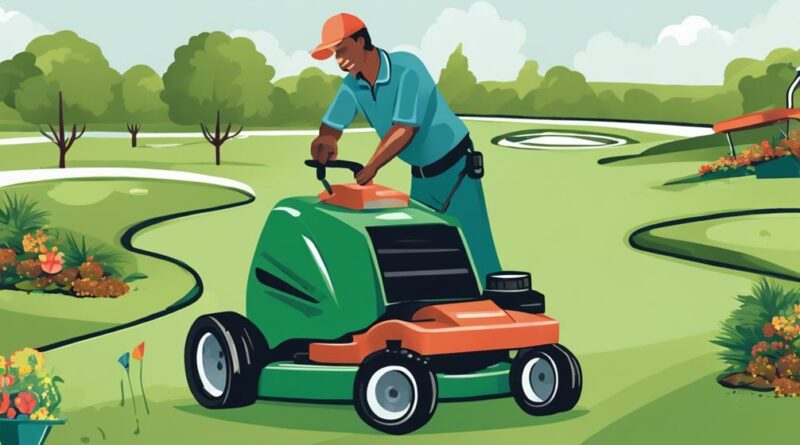Top 10 Green Methods for Golf Course Maintenance
In a world where environmental consciousness is paramount, incorporating sustainable practices into golf course maintenance has become a necessity. Imagine a landscape where lush greens meet eco-friendly solutions for a harmonious balance.
Discover how top industry professionals are revolutionizing traditional maintenance methods with innovative approaches that not only benefit the environment but also enhance the overall golfing experience.
Explore the realm of green methods for golf course maintenance and unlock the secrets to a greener, more sustainable future for the sport.
Water Conservation Techniques
To enhance sustainability on the golf course, consider implementing water conservation techniques. One effective method is to incorporate drought-tolerant landscaping. By selecting plants that require less water to thrive, you can significantly reduce the overall water consumption of the course. Drought-tolerant plants aren't only environmentally friendly but also add a natural aesthetic to the landscape, enhancing the overall appeal of the golf course.
Another key technique to conserve water is the implementation of rainwater harvesting techniques. By installing rain barrels or cisterns, you can collect and store rainwater to be used for irrigation purposes. This reduces the reliance on traditional water sources and helps to offset the water demands of the golf course. Rainwater harvesting is a sustainable practice that not only conserves water but also reduces runoff and erosion on the course.
Incorporating both drought-tolerant landscaping and rainwater harvesting techniques can significantly improve the water conservation efforts of the golf course. These methods not only contribute to a more sustainable environment but also showcase a commitment to responsible water usage. By taking these steps, you can help minimize the environmental impact of golf course maintenance while maintaining the beauty and functionality of the course.
Organic Fertilization Methods
Consider implementing organic fertilization methods to further enhance the sustainability of your golf course maintenance practices. Natural composting is a fantastic way to enrich the soil with essential nutrients while reducing the need for synthetic fertilizers. By utilizing organic materials such as grass clippings, leaves, and food waste, you can create nutrient-rich compost that promotes healthy turf growth and overall soil health.
In addition to natural composting, utilizing eco-friendly pesticides can help maintain a balance between pest control and environmental preservation. These pesticides are derived from natural sources such as plants, minerals, and microbes, making them less harmful to the environment and wildlife. They target specific pests while leaving beneficial insects unharmed, ensuring a more sustainable approach to pest management on your golf course.
Organic fertilization methods not only benefit the environment but also contribute to the long-term health and resilience of your turf. By improving soil structure and promoting microbial activity, organic fertilizers help create a strong foundation for lush and healthy grass growth. Incorporating these methods into your maintenance routine can lead to a more sustainable and environmentally friendly golf course that thrives for years to come.
Integrated Pest Management Strategies
Implementing integrated pest management strategies can effectively control pests while minimizing environmental impact on your golf course. By utilizing a combination of techniques, you can keep pest populations in check without relying solely on harmful chemicals.
Here are some key methods to consider:
- Natural Predator Introduction: Introducing natural predators to your golf course can help keep pest populations under control in a sustainable way. For example, ladybugs can feed on aphids, reducing the need for chemical interventions.
- Chemical Alternatives: Instead of immediately resorting to pesticides, consider using organic or natural alternatives. These can be just as effective in managing pests while being less harmful to the environment and the surrounding wildlife.
- Crop Rotation: Rotating the crops on your golf course can help disrupt pest life cycles and reduce the likelihood of infestations. This simple practice can significantly decrease the need for chemical pest control methods.
- Beneficial Insects: Encouraging the presence of beneficial insects like bees and lacewings can help maintain a healthy ecosystem on your golf course. These insects can prey on harmful pests, acting as a natural form of pest control.
Native Plant Species Utilization
Utilizing native plant species on your golf course can enhance biodiversity and promote ecological balance, complementing the integrated pest management strategies you've already implemented. By incorporating native plants into your landscaping, you not only support the local ecosystem but also reduce the need for excessive watering and chemical inputs.
Drought resistant landscaping is a key benefit of using native plant species. These plants are naturally adapted to the local climate and soil conditions, requiring less water once established. This can lead to significant water savings and lower maintenance costs for your golf course. Additionally, native plants help prevent soil erosion by developing extensive root systems that hold the soil in place, making them excellent erosion control techniques.
Integrating native plant species into your golf course maintenance plan is a sustainable and environmentally friendly approach that can have long-lasting benefits. Consider consulting with local experts to identify suitable native plants for your specific region and microclimate. By promoting the growth of native vegetation, you can create a more resilient and ecologically diverse landscape that enhances the overall beauty and sustainability of your golf course.
Renewable Energy Applications
Incorporate renewable energy applications into your golf course maintenance practices to reduce environmental impact and enhance sustainability. By harnessing the power of solar panels and wind turbines, you can make your golf course more eco-friendly and energy-efficient.
Here are some ways you can integrate renewable energy sources into your maintenance routine:
- Install solar panels: Place solar panels on clubhouse roofs or in open areas around the course to capture sunlight and convert it into electricity.
- Utilize wind turbines: Set up wind turbines strategically to harness wind energy and generate power for irrigation systems or maintenance equipment.
- Combine solar and wind: Create a hybrid system that combines both solar panels and wind turbines to maximize energy production and ensure a consistent power supply.
- Battery storage: Implement battery storage solutions to store excess energy generated by solar panels and wind turbines for later use during periods of low energy production.
Soil Health Improvement Practices
To enhance the sustainability of your golf course maintenance practices, consider adopting soil health improvement techniques for optimal course maintenance. Start by conducting regular soil testing to understand the nutrient levels and pH balance of your soil. This information will help you make informed decisions about fertilization, ensuring that you provide your turf with the necessary nutrients without overapplication.
Another effective soil health improvement practice is the use of cover crops. Cover crops like clover or ryegrass can help prevent soil erosion, suppress weeds, and improve soil structure. These crops also add organic matter to the soil as they decompose, enhancing its overall health and fertility.
Incorporating cover crops into your maintenance routine can reduce the need for chemical inputs, promoting a more natural and eco-friendly approach to turf management. Additionally, cover crops can attract beneficial insects that help control pests, further reducing the reliance on pesticides.
Biodiversity Promotion Approaches

Enhancing biodiversity on your golf course can be achieved through strategic planting and habitat creation initiatives. By implementing the following approaches, you can create a more sustainable and diverse ecosystem:
- Native Plantings: Introducing native plants on your golf course not only enhances its natural beauty but also provides essential habitats for local wildlife to thrive.
- Wildlife Habitats: Designating specific areas as wildlife habitats by incorporating features like bird boxes, bat houses, and pollinator gardens can attract a variety of species, contributing to a richer biodiversity.
- Pond Development: Constructing or preserving ponds and wetlands helps support aquatic life and provides a vital water source for various organisms, promoting ecosystem balance.
- Insect-Friendly Landscaping: Encouraging the presence of beneficial insects by planting diverse vegetation and minimizing pesticide use can help maintain a healthy ecological balance on your golf course.
Sustainable Irrigation Systems
To improve resource efficiency and environmental sustainability on your golf course, consider implementing sustainable irrigation systems that benefit both your landscapes and the surrounding ecosystem.
One effective method is to incorporate drought-resistant plants into your course's design. These plants have evolved to thrive in arid conditions, requiring significantly less water than traditional plant species. By integrating drought-resistant plants into your landscaping, you can reduce the overall water consumption of your course, resulting in cost savings and a more environmentally friendly approach to irrigation.
Another key aspect of sustainable irrigation systems is the implementation of rainwater harvesting techniques. Capturing rainwater allows you to collect and store precipitation for later use in watering your golf course. This reduces the reliance on freshwater sources for irrigation, minimizing the impact on local water supplies and ecosystems. Rainwater harvesting also helps prevent soil erosion and runoff, as the collected water can be distributed more evenly across the course, promoting healthier plant growth.
Frequently Asked Questions
How Can Golf Courses Reduce Their Carbon Footprint Through Transportation and Equipment Maintenance Practices?
To reduce your carbon footprint in golf courses, focus on energy-efficient transportation and equipment maintenance. Opt for electric or hybrid vehicles and maintain them regularly for optimal performance.
Embrace green landscaping practices like using organic fertilizers and natural pest control methods. Consider carbon footprint offsets such as planting trees or investing in renewable energy projects.
What Are Some Innovative Ways Golf Courses Can Engage the Local Community in Environmental Conservation Efforts?
To engage the local community in environmental conservation efforts, consider hosting workshops on sustainable practices and wildlife preservation. Encourage participation in clean-up events and tree planting initiatives. Collaborate with schools for educational programs on environmental conservation.
By fostering a sense of responsibility and awareness, the community can actively contribute to preserving the environment.
Community engagement and environmental education are key to creating a sustainable and eco-friendly environment for all.
Are There Any Specific Certifications or Accreditations That Golf Courses Can Obtain to Showcase Their Commitment to Sustainability?
To showcase your commitment to sustainability, consider seeking certification programs that validate your sustainable practices. These certifications not only demonstrate your dedication to environmental conservation but also attract environmentally conscious golfers.
How Do Golf Courses Manage and Minimize Waste, Such as Grass Clippings and Other Organic Materials?
To manage and minimize waste like grass clippings and organic materials, golf courses implement composting programs to turn green waste into rich soil. Recycling initiatives are also crucial for reusing materials like plastic and metal.
What Are Some Ways Golf Courses Can Address Water Pollution and Runoff From Their Facilities?
To address water pollution and runoff, you can implement sustainable landscaping practices like using native plants that require less water. By conserving water through efficient irrigation systems, you reduce runoff.
Managing stormwater with techniques such as rain gardens helps prevent pollution. Erosion control methods like planting cover crops and establishing buffer zones along water bodies also aid in maintaining water quality on your golf course.
Conclusion
In conclusion, by implementing these top 10 green methods for golf course maintenance, you can significantly reduce your environmental impact while still maintaining a beautiful and playable course.
From conserving water to promoting biodiversity, these sustainable practices not only benefit the environment but also contribute to a healthier and more resilient golf course.
So, go green and make a positive difference in the world of golf course maintenance today!
